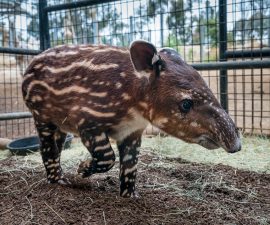When our boisterous baboon band charges into their expansive, naturalistic habitat, the daily spectacle stops Zoo visitors in their tracks.
BY Donna Parham
Photography by Ken Bohn
Each morning, eager to explore, a band of hamadryas baboons Papio hamadryas rockets out of their bedrooms, their enthusiastic chorus of low grunts resounding through the Africa Rocks habitat. The large monkeys—20 in all—range in age from 5 months to 23 years old. They gambol single-file atop the ridge and scramble up and down the craggy cliff faces. Some initiate a romp around the perimeter, and a playful pair bounds high into a tree. As they settle in, the vocalizations become less frequent, but the activity doesn’t slow down. The monkeys keep busy—grooming each other, peeling bark, uprooting grass, chomping on leaves, and chasing each other. Baby Christina scampers into the arms of two-year-old Sadie, even as mom Kurzbein keeps a firm grasp on her infant’s tail.
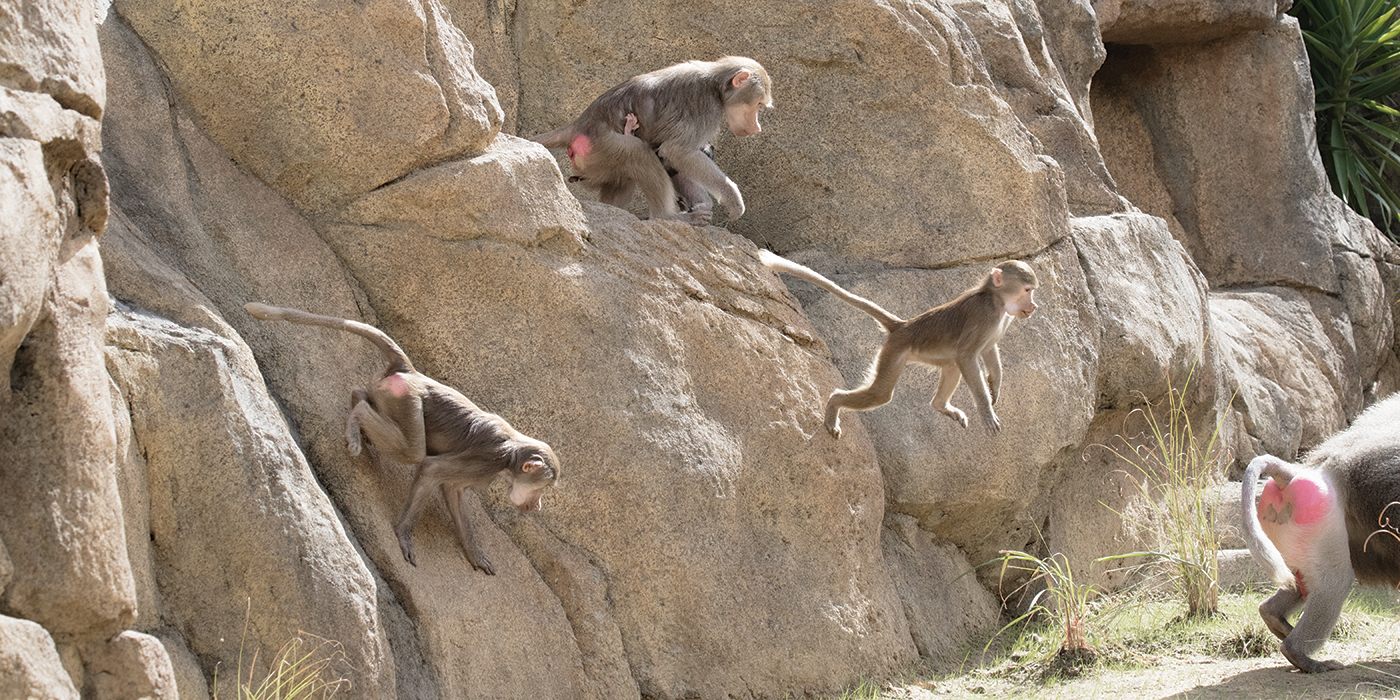
BUSY MONKEYS
The new hamadryas baboon exhibits in Africa Rocks provide the monkeys with a wide variety of environmental enrichment opportunities.
RELATIONSHIP ISSUES
Like their counterparts in the wild, this band of 8 males and 12 females depends on a complex social structure. An adult male hamadryas baboon assembles a group of females that he monopolizes, socially and reproductively—or at least he tries to. His group, plus all their offspring, is called a one-male unit (OMU), and it’s a basic building block of hamadryas society. All the females are subordinate to their OMU leader. At the Zoo, that’s a 19-year-old male named Elvis.
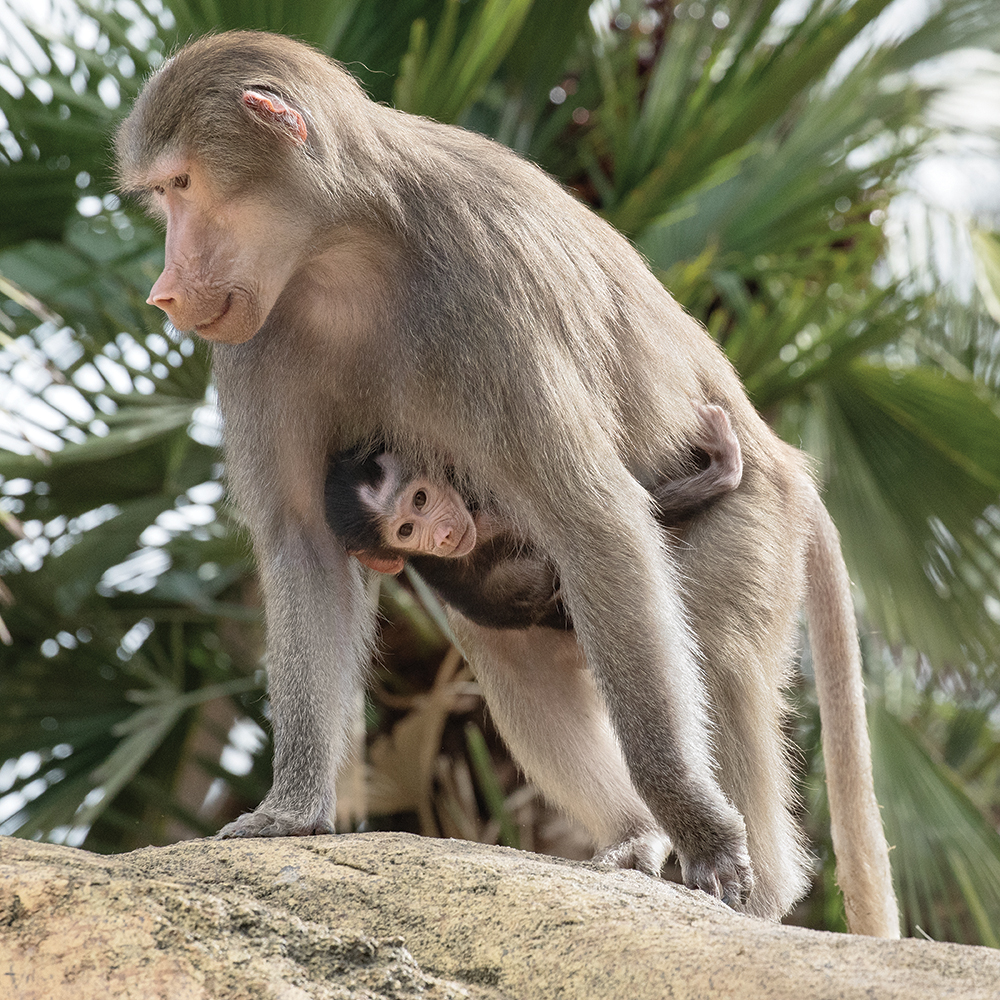
YA GOTTA SEE THE BABY!
Baby baboon Christina was born to mom Kurzbein at the Zoo, where visitors will get to watch her grow up.
In contrast to many monkey species—in which females maintain close bonds associated with family relationships—the strongest social bonds in hamadryas society are between a female and her OMU leader. And there is a hierarchy among the females, albeit one that is ever changing. Since Kurzbein gave birth to baby Christina at the Zoo in late 2017, she seems to be Elvis’ number one—for now. “A female named Irokese used to be the ‘Queen Bee,’ but they kind of defer to the mom of a new baby,” says Dustin Black, senior keeper. “The highest-ranking females stay physically closest to Elvis, and the lower-ranking females are farther away, on the fringes of the group.”
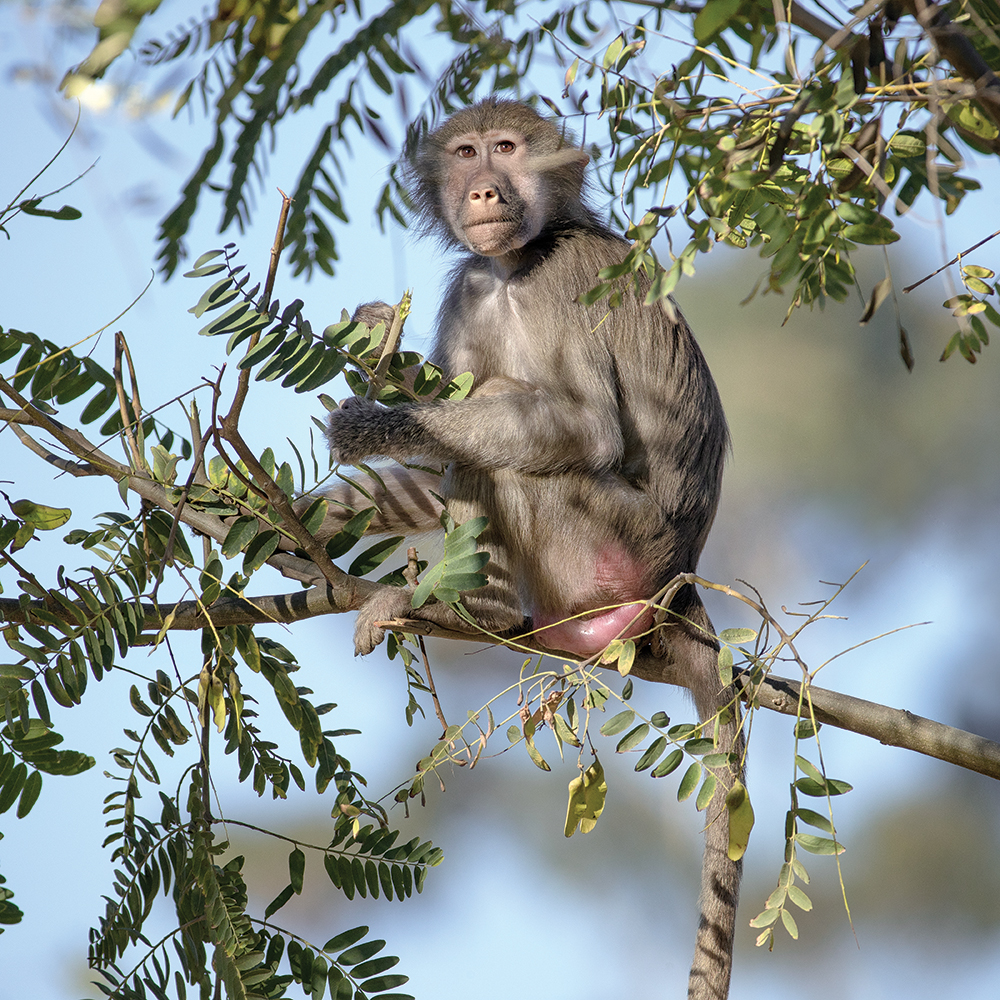
IN THE TREETOPS
Although baboons are among the most terrestrial monkeys, they are good climbers, too.
 Want to get to know the hamadryas baboons even better? Click here to for San Diego Zoo’s Baboon Cam!
Want to get to know the hamadryas baboons even better? Click here to for San Diego Zoo’s Baboon Cam!
“There is definitely ‘drama,’” says Dustin—and that’s a positive sign that the animals are demonstrating the same kind of natural behavior as they would in the wild. In hamadryas society, it’s normal for females within the same OMU to threaten each other with eyebrow raises, screaming, slapping the ground, and even hitting. On the flip side, females are just as likely to groom each other or engage in a quick embrace. The natural history of hamadryas baboons guides keepers in how to best support husbandry standards. So for the most part, the animals work out their social structure and each member’s place in it, with minimal interference from their keepers. “I’m very impressed with how Elvis maintained his group throughout their move from Europe, the quarantine process, and the final transfer to the Zoo,” says Dean Gibson, curator of primates. “I really expected more aggression and fractioning. It says a lot about Elvis that he was able to keep everybody calm, cool, and collected while they were in holding and when they were reunited.”
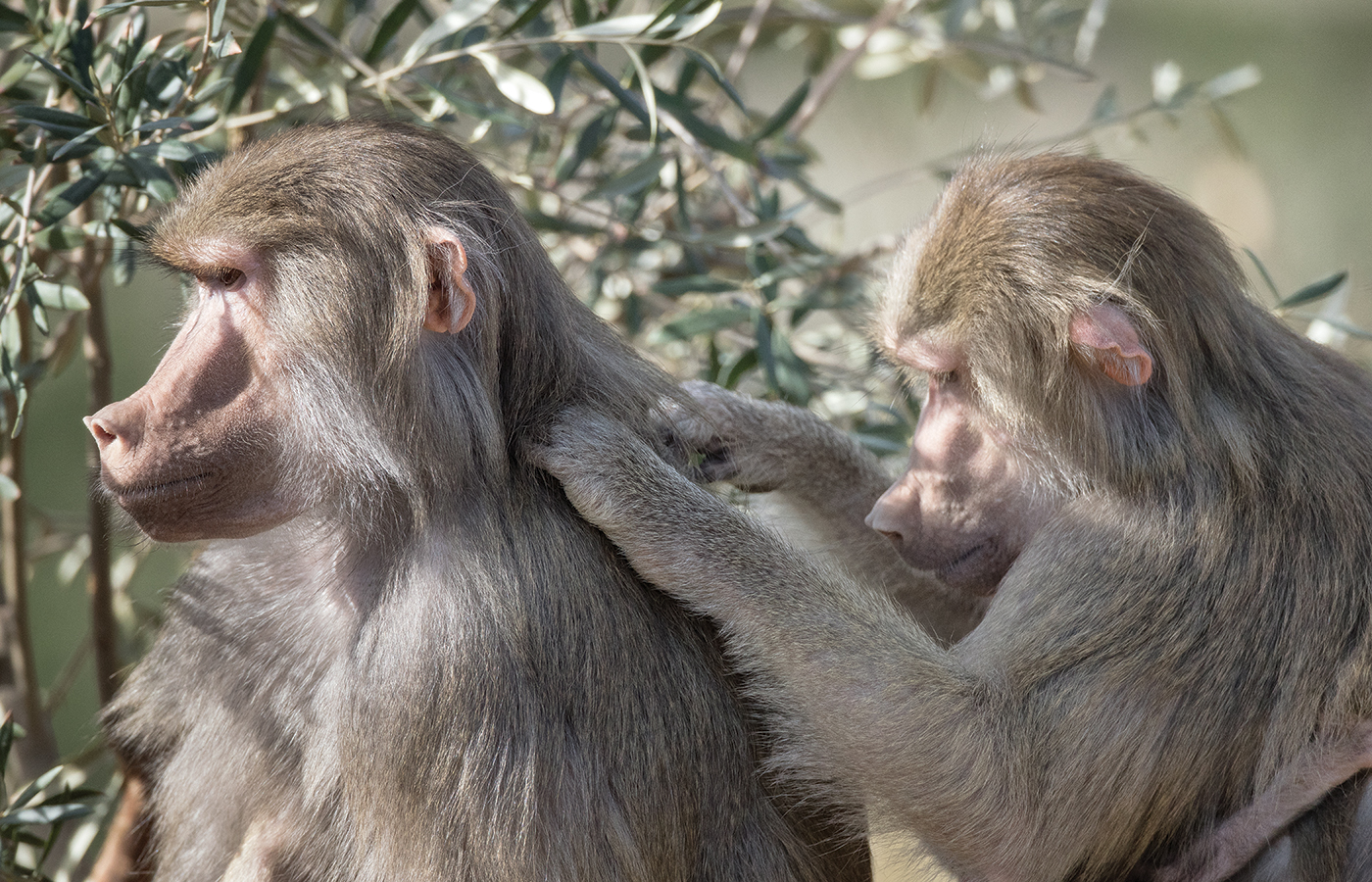
GIRL BONDING TIME
Grooming one another strengthens a baboon relationship.
SIGNIFICANT OTHERS
For the time being, the younger seven males live on the periphery of Elvis’ OMU as follower males. Although followers socialize with the rest of the OMU, the OMU leader does his best to monopolize mating. Dustin has noticed that females Brittnay and Estilista—low ranking in Elvis’ group—seem to have taken up with a young male named Tabuk. Subadult male Lex has befriended a female named Anakin. “Those friendly relationships place the males at an advantage when they are old enough to recruit females for their own OMUs,” says Dean.
When a follower male challenges an OMU leader for control of a female, the interaction is likely to turn aggressive. A leader “manages with aggression when he needs to,” says Dean. “They do have their squabbles, and then there’s lots of screaming.” But although Zoo guests may see some very dramatic behaviors—including teeth baring and conflict—these behaviors are critical to maintaining a functional social structure. And despite the fierce nature of these exchanges, injuries are rare. “They don’t hold a grudge,” says Dustin. The males sort it out, and they reestablish friendly relationships quickly. To make up, one or both presents its rear end, and often, the other male touches it.
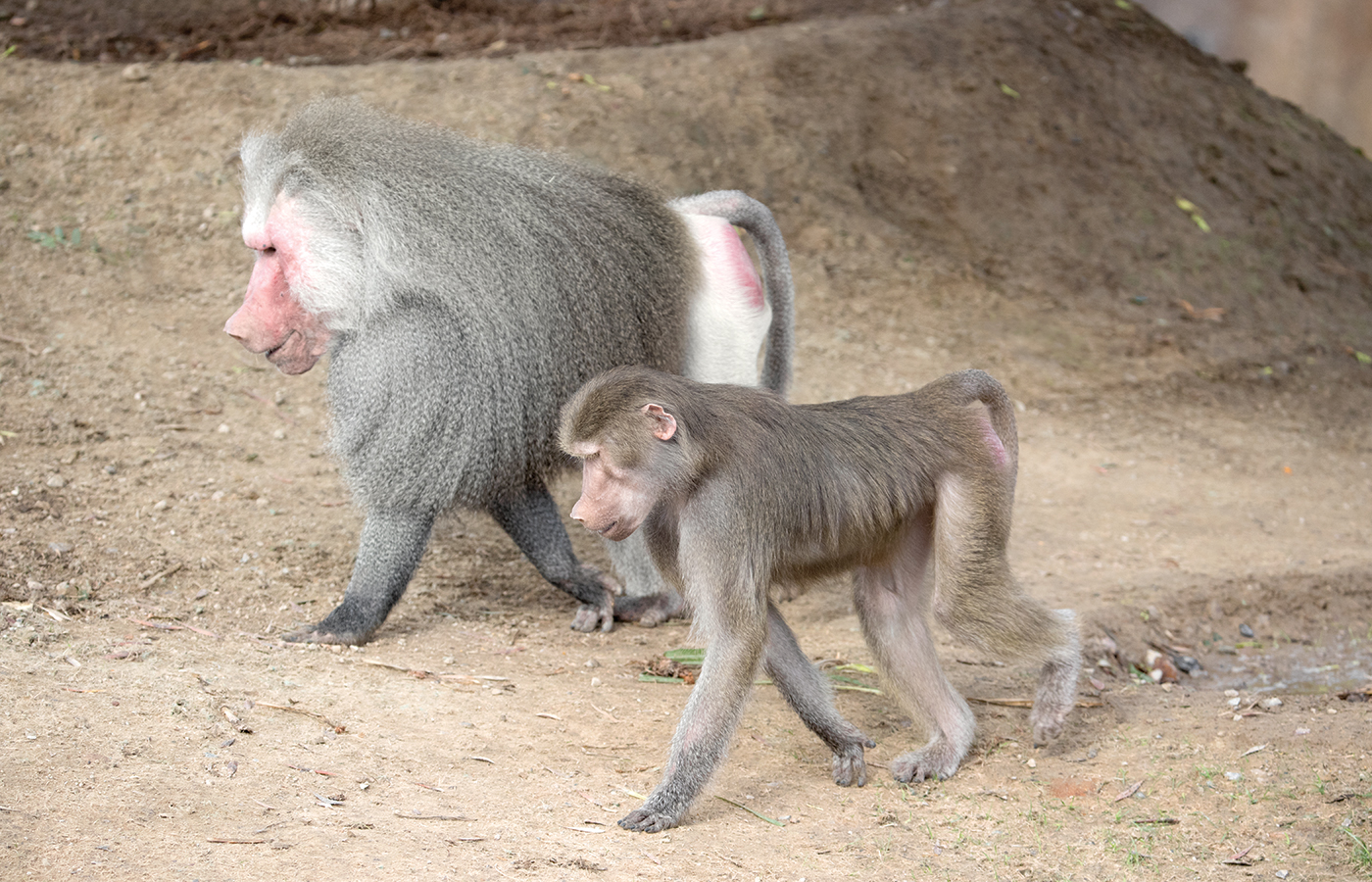
MALE AND FEMALE
A male hamadryas baboon has an immense head with an impressive muzzle, and a long, thick, silvery mane and cape; he can be twice the size of a female.
FAMILY MATTERS
“Baboons are iconic African primates,” says Dean. “Most people see olive, yellow, or chacma baboons if they visit Africa; the only way you would ever see hamadryas baboons is if you made a special trip to the Ethiopian Highlands.” So why do we have hamadryas here? The Zoo is playing a key role in the Association of Zoos and Aquariums Species Survival Plan (SSP). “The SSP team recognized that they needed new bloodlines as well as additional space,” says Dean. “So, working with the SSP coordinator, we identified a group of baboons in Germany’s Frankfurt Zoo that they were willing to move here.” That was Elvis’ group—all 19 of them (now 20, with the birth of Christina).
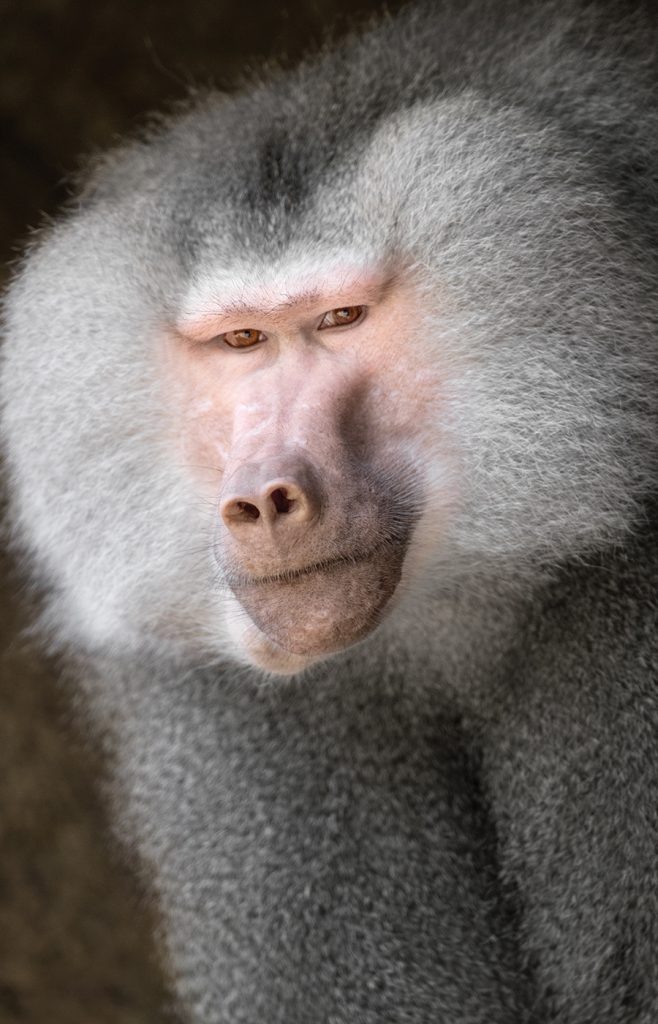
WATCHFUL
As a species, hamadryas baboons aren’t endangered, but in some parts of their range, they are losing habitat due to agricultural expansion and irrigation projects.
Early in 2018, we’ll be adding some new baboon faces. “Based on SSP recommendations, we will be managing some new OMUs to keep the population genetically healthy,” says Dean. That means keepers will be playing matchmaker. The two spacious outdoor exhibits and several off-exhibit areas in Africa Rocks will allow them to introduce unrelated males and females, to encourage new OMUs—away from Elvis’ watchful eye!




